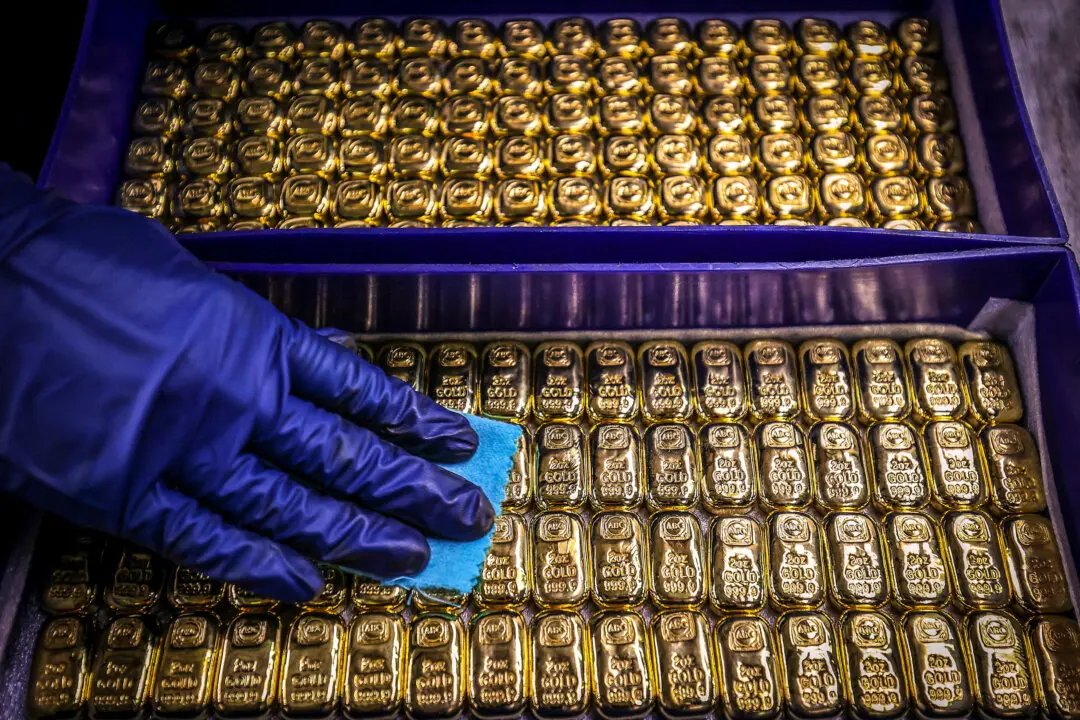Gold prices registered their fourth consecutive weekly gain, ending the Jan. 24 trading session shy of the all-time high recorded in October.
February gold futures rose $12.30, or 0.44 percent, to $2,777.30 per ounce on the COMEX division of the New York Mercantile Exchange. The precious metal posted a weekly boost of 1.36 percent, adding to this month’s rise of more than 5 percent.
Gold registered an all-time high on Oct. 31, 2024, rising to $2,790.15.
Silver, the sister commodity to gold, topped $31 to end the trading week. March silver futures picked up $0.198, or 0.64 percent, to $31.04. The white metal finished the week flat and is up nearly 6 percent to kick off 2025.
The yellow metal has found support on a weaker U.S. dollar as financial markets bet that President Donald Trump is softening his trade stance.
Trump told reporters on Jan. 23 that he had a friendly conversation with Chinese leader Xi Jinping and is confident the United States can reach a trade agreement with China.
Hours after being inaugurated, the president signed a trade memorandum, directing federal departments and agencies to study trade relationships and how other countries manage their currencies.
While Trump stopped short of introducing sweeping tariffs, he announced that he is considering imposing levies on Canada, Mexico, China, and the European Union on Feb. 1.
The new administration’s trade position has generated uncertainty among investors, sending traders into the conventional safe-haven asset. The belief that Trump may not be as aggressive on tariffs has also weighed on the greenback.
“The U.S. dollar has backed off from its recent highs after an impressive rally after the election,” Mukarram Mawjood, the CIO of Blackstone Commodity Group, told The Epoch Times.
“Trump’s sweeping executive orders have ignited fears of global trade uncertainty and the threat of tariffs not just against China but other U.S. allies that could cripple emerging market economies.”
The U.S. Dollar Index (DXY)—a gauge of the buck against a weighted basket of currencies like the euro and the Japanese yen—tumbled 0.54 percent to 107.47. The index posted a 1.72 percent weekly drop, the sharpest decline since November 2023. The DXY is also close to 1 percent in January.
A weaker greenback is good for dollar-denominated commodities like gold because it makes it cheaper for foreign investors to purchase.
The financial markets closely monitored Trump’s remarks during the World Economic Forum in Davos, Switzerland, on Jan. 23. The recently inaugurated president revealed that he intends to ask the Federal Reserve to relax monetary policy.
“I’ll demand that interest rates drop immediately,” Trump said. “And likewise, they should be dropping all over the world. Interest rates should follow us all over.”

The futures market does not anticipate the next interest rate cut until June or July.
Trump’s comments sent U.S. Treasury yields slightly lower.
The benchmark 10-year yield shed 2 basis points to 4.617 percent. The 20- and 30-year yields dipped to 4.912 percent and 4.843 percent, respectively.
Lower interest rates are typically positive for non-yielding bullion because they diminish the opportunity cost—an economic concept depicting the value of the next best alternative that investors abandon when making another decision—of holding gold.
Investment demand and central bank buying have ostensibly created a “soft floor” in the metals market, says Ole Hansen, the head of commodity strategy at Saxo Bank.
The organization will release the complete 2024 data on Feb. 5.
As for prices, gold could reach $3,000 by the end of the year, says Rick Kanda, the managing director of The Gold Bullion Company.
Because of geopolitical tensions, increased political uncertainty, and monetary policy changes, gold could repeat its 2024 performance this year.
“Overall, it looks to me that 2025 will be another extremely successful year for gold investment that’s bound to be a part of many people’s investment portfolios,” Kanda said in a statement to The Epoch Times.







